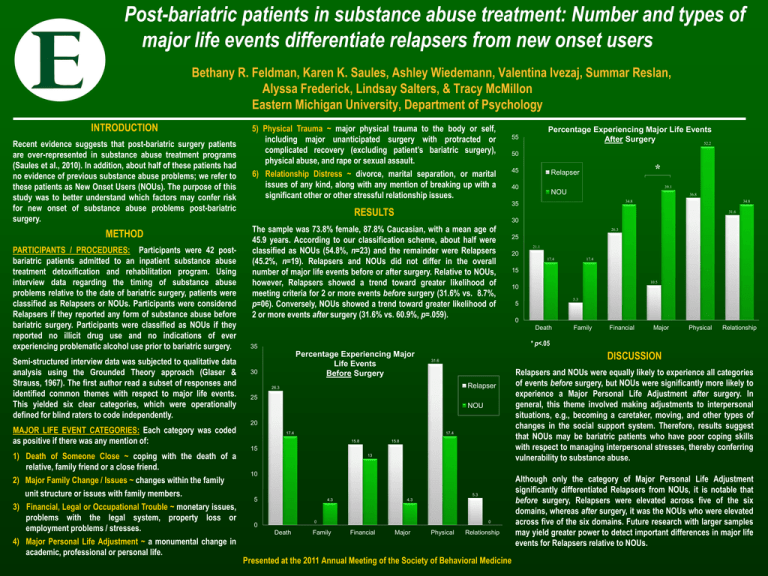
Post-bariatric patients in substance abuse treatment: Number and types of
major life events differentiate relapsers from new onset users
Bethany R. Feldman, Karen K. Saules, Ashley Wiedemann, Valentina Ivezaj, Summar Reslan,
Alyssa Frederick, Lindsay Salters, & Tracy McMillon
Eastern Michigan University, Department of Psychology
INTRODUCTION
Recent evidence suggests that post-bariatric surgery patients
are over-represented in substance abuse treatment programs
(Saules et al., 2010). In addition, about half of these patients had
no evidence of previous substance abuse problems; we refer to
these patients as New Onset Users (NOUs). The purpose of this
study was to better understand which factors may confer risk
for new onset of substance abuse problems post-bariatric
surgery.
METHOD
PARTICIPANTS / PROCEDURES: Participants were 42 postbariatric patients admitted to an inpatient substance abuse
treatment detoxification and rehabilitation program. Using
interview data regarding the timing of substance abuse
problems relative to the date of bariatric surgery, patients were
classified as Relapsers or NOUs. Participants were considered
Relapsers if they reported any form of substance abuse before
bariatric surgery. Participants were classified as NOUs if they
reported no illicit drug use and no indications of ever
experiencing problematic alcohol use prior to bariatric surgery.
Semi-structured interview data was subjected to qualitative data
analysis using the Grounded Theory approach (Glaser &
Strauss, 1967). The first author read a subset of responses and
identified common themes with respect to major life events.
This yielded six clear categories, which were operationally
defined for blind raters to code independently.
MAJOR LIFE EVENT CATEGORIES: Each category was coded
as positive if there was any mention of:
1) Death of Someone Close ~ coping with the death of a
relative, family friend or a close friend.
2) Major Family Change / Issues ~ changes within the family
unit structure or issues with family members.
3) Financial, Legal or Occupational Trouble ~ monetary issues,
problems with the legal system, property loss or
employment problems / stresses.
4) Major Personal Life Adjustment ~ a monumental change in
academic, professional or personal life.
5) Physical Trauma ~ major physical trauma to the body or self,
including major unanticipated surgery with protracted or
complicated recovery (excluding patient’s bariatric surgery),
physical abuse, and rape or sexual assault.
6) Relationship Distress ~ divorce, marital separation, or marital
issues of any kind, along with any mention of breaking up with a
significant other or other stressful relationship issues.
Percentage Experiencing Major Life Events
After Surgery
52.2
55
50
45
40
39.1
NOU
34.8
30
26.3
25
21.1
20
17.4
10.5
10
5.3
5
0
* p<.05
35
Percentage Experiencing Major
Life Events
Before Surgery
31.6
Relapser
26.3
25
NOU
20
17.4
17.4
15.8
15
13
10
5.3
4.3
4.3
0
0
0
Death
Family
Financial
Major
Physical
Relationship
Presented at the 2011 Annual Meeting of the Society of Behavioral Medicine
17.4
15
Death
5
34.8
31.6
The sample was 73.8% female, 87.8% Caucasian, with a mean age of
45.9 years. According to our classification scheme, about half were
classified as NOUs (54.8%, n=23) and the remainder were Relapsers
(45.2%, n=19). Relapsers and NOUs did not differ in the overall
number of major life events before or after surgery. Relative to NOUs,
however, Relapsers showed a trend toward greater likelihood of
meeting criteria for 2 or more events before surgery (31.6% vs. 8.7%,
p=06). Conversely, NOUs showed a trend toward greater likelihood of
2 or more events after surgery (31.6% vs. 60.9%, p=.059).
15.8
36.8
35
RESULTS
30
*
Relapser
Family
Financial
Major
Physical
Relationship
DISCUSSION
Relapsers and NOUs were equally likely to experience all categories
of events before surgery, but NOUs were significantly more likely to
experience a Major Personal Life Adjustment after surgery. In
general, this theme involved making adjustments to interpersonal
situations, e.g., becoming a caretaker, moving, and other types of
changes in the social support system. Therefore, results suggest
that NOUs may be bariatric patients who have poor coping skills
with respect to managing interpersonal stresses, thereby conferring
vulnerability to substance abuse.
Although only the category of Major Personal Life Adjustment
significantly differentiated Relapsers from NOUs, it is notable that
before surgery, Relapsers were elevated across five of the six
domains, whereas after surgery, it was the NOUs who were elevated
across five of the six domains. Future research with larger samples
may yield greater power to detect important differences in major life
events for Relapsers relative to NOUs.







